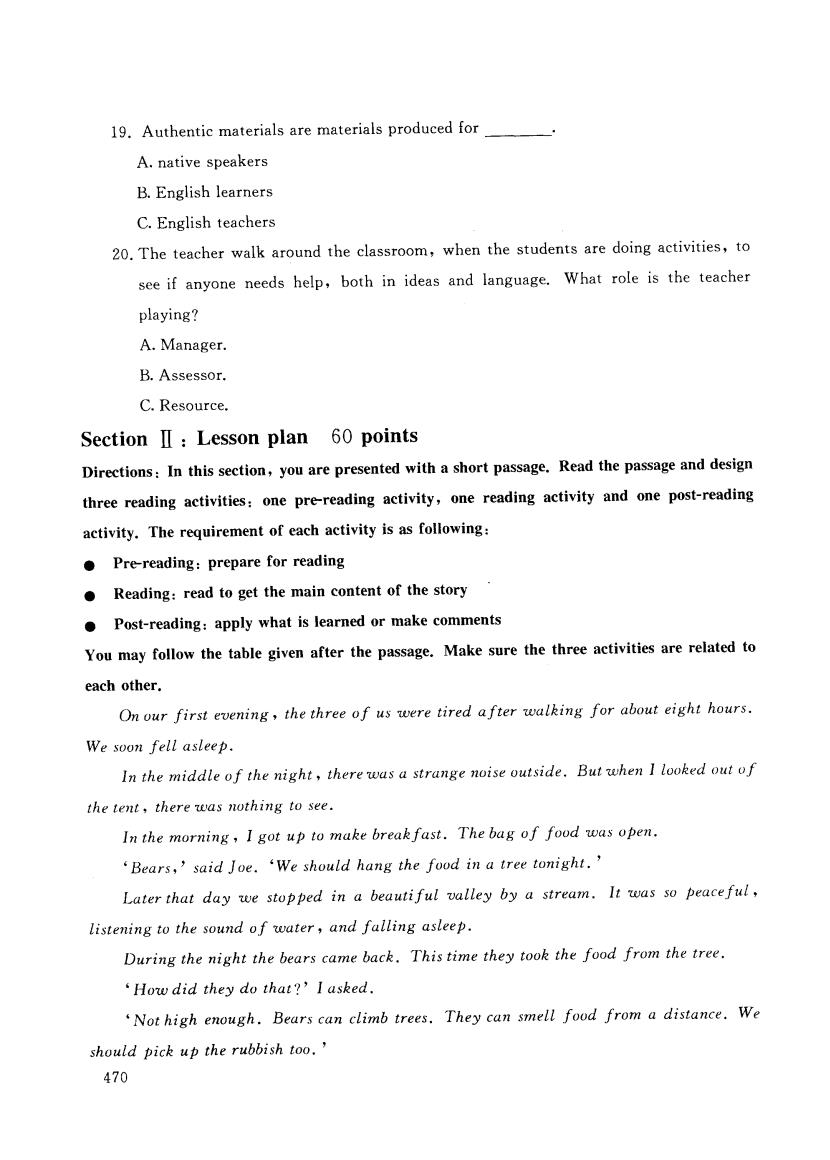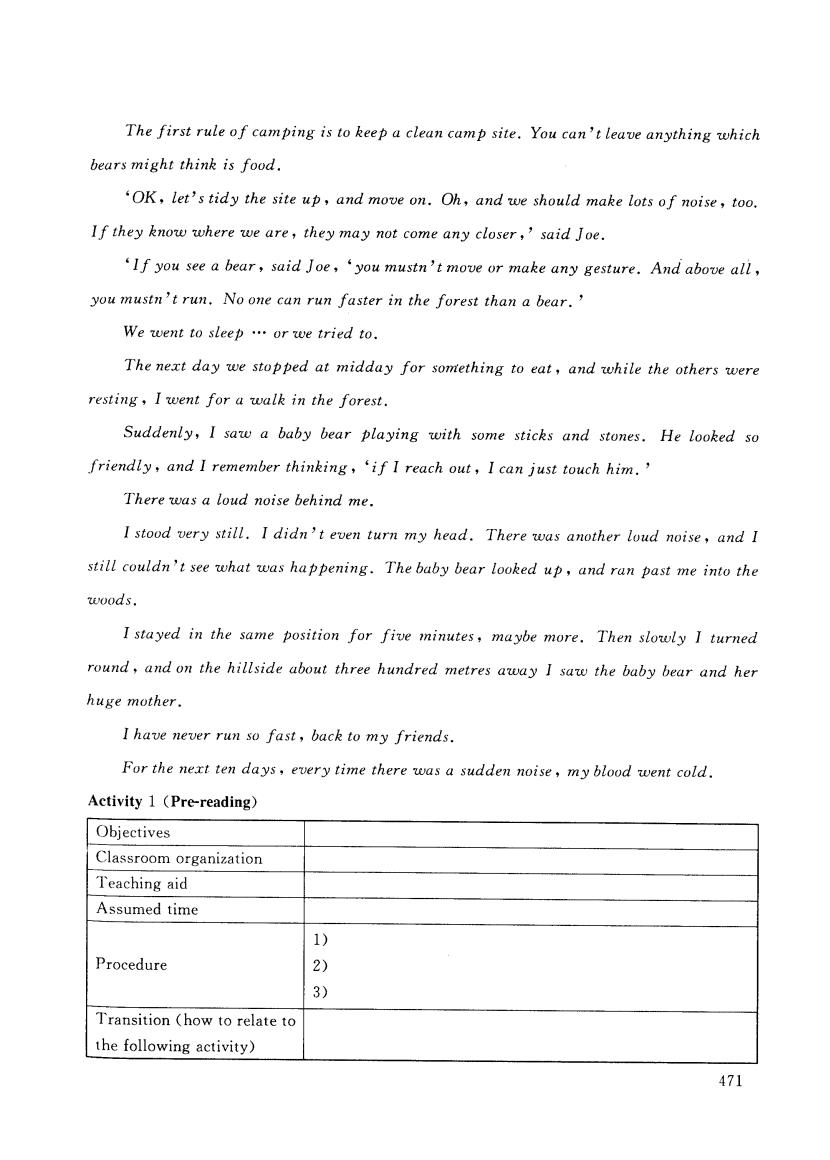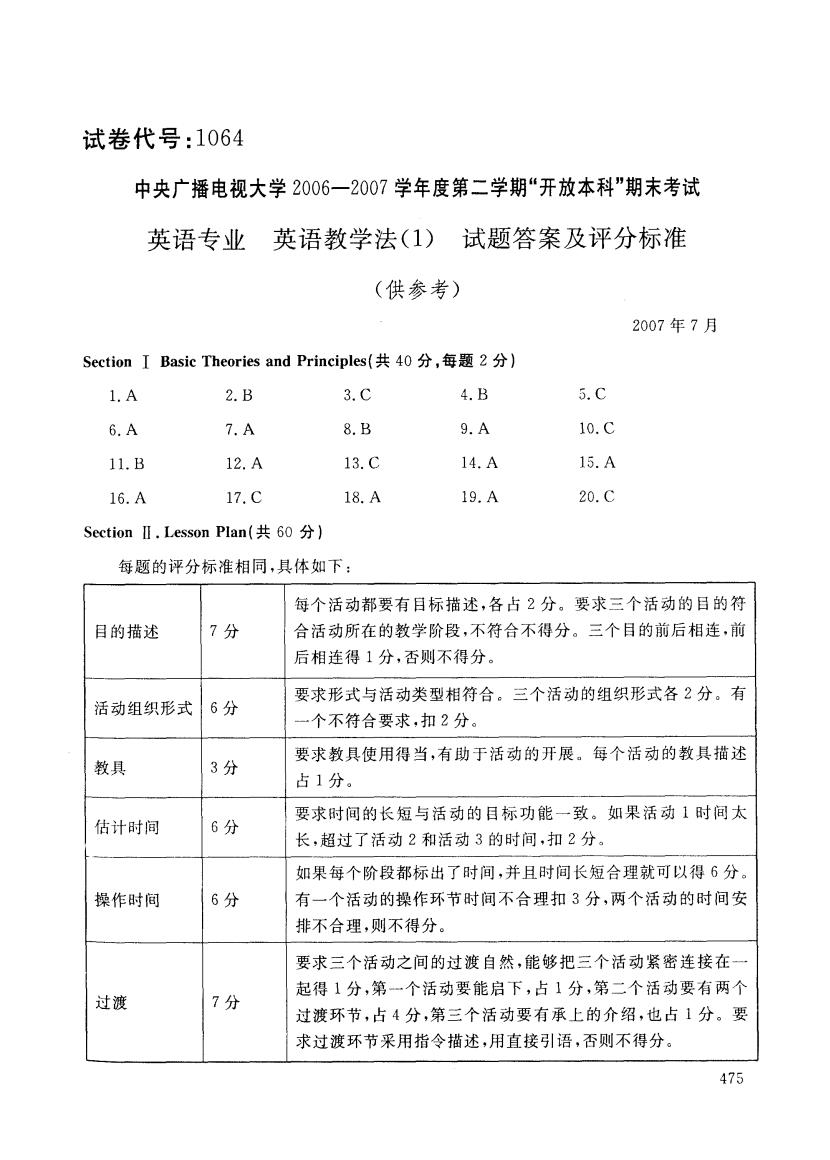
试卷代号:1064 中央广播电视大学2006一2007学年度第二学期“开放本科”期末考试 英语专业 英语教学法(1)试题 2007年7月 注意事项 一、将你的学号、姓名及分校(工作站)名称填写在答题纸的规定栏 内。考试结束后,把试卷和答题纸放在桌上。试卷和答题纸均不得带 出考场。监考人收完考卷和答题纸后才可离开考场。 二、仔细读懂题目的说明,并按题目要求和答题示例答题。答案一 定要写在答题纸的指定位置上,写在试卷上的答案无效。 三、用蓝、黑圆珠笔或钢笔答题,使用铅笔答题无效。 466
试卷代号:1064 中央广播电视大学2006-2007学年度第二学期“开放本科”期末考试 英语专业 英语教学法(1) 试题 2007年 7月 注 意 事 项 一、将你的学号、姓名及分校(工作站)名称填写在答题纸的规定栏 内。考试结束后,把试卷和答题纸放在桌上。试卷和答题纸均不得带 出考场。监考人收完考卷和答题纸后才可离开考场。 二、仔细读懂题 目的说明,并按题 目要求和答题示例答题。答案一 定要写在答题纸的指定位置上,写在试卷上的答案无效。 三、用蓝、黑圆珠笔或钢笔答题,使用铅笔答题无效

Section I:Basic Theories and Principles 40 points Questions 1-20 are based on this part. Directions:Choose the best answer from A,B or C for each question.Write your answer on the Answer Sheet. 1.Which of the following activities is communicative? A.Jigsaw listening. B.Sentence making. C.Drilling exercises. 2.What does the communication approach treat language as? A.A system. B.A means of communication. C.A set of habits. 3.Which of the following belongs to behaviorism? A.Use of native language in learning. B.Problem solving tasks. C.Pattern drills. 4.Which of the following is the description of a function? A.Ownership. B.Giving directions. C.Acting out a play. 5.What approach treats the students as a whole person,with feelings and emotions? A.The Natural Approach. B.The Communicative Approach. C.The Humanistic Approach. 6.Which of the following should most concern us when designing a syllabus? A.Needs of the learners. B.Lacks of the learners. C.Wants of the learners. 467
Section I:Basic Theories and Principles 40 points Questions 1一20 are based on this part. Directions:Choose the best answer from A, B or C for each question. Write your answer on the Answer Sheet. 1. Which of the following activities is communicative? A. Jigsaw listening. B. Sentence making. C. Drilling exercises. 2. What does the communication approach treat language as? A. A system. B. A means of communication. C. A set of habits. 3. Which of the following belongs to behaviorism? A. Use of native language in learning. B. Problem solving tasks. C. Pattern drills. 4. Which of the following is the description of a function? A. Ownership. B. Giving directions. C. Acting out a play. 5. What approach treats the students as a whole person, with feelings and emotions? A. The Natural Approach. B. The Communicative Approach. C. The Humanistic Approach. 6. Which of the following should most concern us when designing a syllabus? A.Needs of the learners. B. Lacks of the learners. C. Wants of the learners

7.What does "locating the specific information"help to train? A.Scanning. B.Skimming. C.Inferring. 8.Which of the following activities can be used at the while-reading stage? A.Predicting the story to read. B.Skimming to find the gist. C.Associating the story with one's own experience. 9.What may constitute the difficulty in comprehending the following passage? For the Arab the location of the person in relation to the body is quite different.The person exists somewhere down inside the body.The ego is not completely hidden, however,because it can be reached very easily with an insult.It is protected from touch but not from words. A.Background knowledge. B.Language. C.Type of writing. 10.Which of the following speaking activities is most communicative? A.Using pictures to make up stories. B.Prompted dialogues. C.Interviews using a questionnaire. 11.Which of the following questions exemplifies the consideration for information input in designing a speaking activity? A.Can the students learn about new things besides the language itself? B.What language items are students expected to learn? C.What roles are students expected to play and how should they play them? 12.What listening skill does the following activity help to train? Listen to the following text and answer the multiple-choice question. In this dialogue,the speakers are talking about A)going to a picnic B)attending a concert C)having a party A.Listening for gist. B.Listening for specific information. C.Listening for detailed information. 468
7. What does "locating the specific information" help to train? A. Scanning. B. Skimming. C. Inf erring. 8. Which of the following activities can be used at the while-reading stage? A. Predicting the story to read. B. Skimming to find the gist. C. Associating the story with one's own experience. 9. What may constitute the difficulty in comprehending the following passage? For the Arab the location of the person in relation to the body is quite di f ferent. The person exists somewhere down inside the body. The ego is not completely hidden, however, because it can be reached very easily with an insult. It is protected from touch but not from words. A. Background knowledge. B. Language. C. Type of writing. 10. Which of the following speaking activities is most communicative? A. Using pictures to make up stories. B. Prompted dialogues. GInterviews using a questionnaire. 11. Which of the following questions exemplifies the consideration for information input in designing a speaking activity? A. Can the students learn about new things besides the language itself? B. What language items are students expected to learn GWhat roles are students expected to play and how should they play them 12. What listening skill does the following activity help to train Listen to the following text and answer the multiple-choice questioJt. In this dialogue,the speakers are talking about_ . A) going to a picnic B)attending a concert C) having a party A. Listening for gist. B. Listening for specific information. C. Listening for detailed information. 468

13.Which of the following activities should we choose to train the listening skill of inferring? A.Spot dictation. B.Picture prediction. C.Questions and answers. 14.Which of the following features spoken English? A.It is context independent. B.It is produced with little redundancy. C.It is produced with good organization. 15.Which of the following methods does not tolerate errors? A.The Audio-lingual Method. B.The Communicative Approach. C.The Direct Method. 16.In which of the following activities is the teacher more of a controller? A.Presenting new language. B.Organizing a role-play activity. C.Getting feedback. 17.In which of the following activities does the teacher mainly play the role of a prompter? A.Organizing the students to do activities by giving instructions. B.Changing the pace of the class by various means. C.Eliciting ideas from students. 18.What is trained in the following activity? beat-bit seat-sit meat -mit A.Articulation. B.Stress. C.Rhythm. 469
13. Which of the following activities should we choose to train the listening skill of inferring? A. Spot dictation. B. Picture prediction. C. Questions and answers. 14. Which of the following features spoken English? A. It is context independent. B. It is produced with little redundancy. C. It is produced with good organization. 15. Which of the following methods does not tolerate errors? A. The Audio-lingual Method. I3. The Communicative Approach. C. The Direct: M ethod. 16. In which of the following activities is the teacher more of a controller? A. Presenting new language. B. Organizing a role-play activity. C. Getting feedback. 17. In which of the following activities does the teacher mainly play the role of a prompter? A. Organizing the students to do activities by giving instructions. B. Changing the pace of the class by various means. C. Eliciting ideas from students. 18. What is trained in the following activity? A. Articulation. B. Stress. C. Rhythm. 469

19.Authentic materials are materials produced for A.native speakers B.English learners C.English teachers 20.The teacher walk around the classroom,when the students are doing activities,to see if anyone needs help,both in ideas and language.What role is the teacher playing? A.Manager. B.Assessor. C.Resource. SectionⅡ:Lesson plan60 points Directions:In this section,you are presented with a short passage.Read the passage and design three reading activities:one pre-reading activity,one reading activity and one post-reading activity.The requirement of each activity is as following: Pre-reading:prepare for reading Reading:read to get the main content of the story Post-reading:apply what is learned or make comments You may follow the table given after the passage.Make sure the three activities are related to each other. On our first evening,the three of us were tired after walking for about eight hours. We soon fell asleep. In the middle of the night,there was a strange noise outside.But when I looked out of the tent,there was nothing to see. In the morning,I got up to make breakfast.The bag of food was open. 'Bears,'said Joe.'We should hang the food in a tree tonight.' Later that day we stopped in a beautiful valley by a stream.It was so peaceful, listening to the sound of water,and falling asleep. During the night the bears came back.This time they took the food from the tree. 'How did they do that?'I asked. 'Not high enough.Bears can climb trees.They can smell food from a distance.We should pick up the rubbish too.' 470
19. Authentic materials are materials produced for_ · A. native speakers I3. English learners C. English teachers 20. The teacher walk around the classroom, when the students are doing activities, to see if anyone needs help,both in ideas and language. What role is the teacher playing? A. Manager. B. Assessor. C. Resource. Section Directions fl:Lesson plan 60 points In this section, you are presented with three reading activity, The activities on e pre-reading activity, a short passage. Read the passage and design one reading activity and one post-reading requirement Pre-reading: prepare of each activity is as following; for reading Reading; read to get the main content of the story Post-reading: apply what is learned or make comments … You may follow the table given after the passage. Make sure the three activities are related to each other, On our first evening,the three of us were tired after walking for about eight hours. We soon fell asleep. In the middle of the night,there was a strange noise outside. But when I looked out o f the tent,there was nothing to see. In the morning,I got up to make break fast. The bag of food was open. ‘Bears,’said Joe.‘We should hang the food in u tree tonight.’ Laterthat day we stopped in a beautiful volley by u stream. It was so peaceful, listening to the sound of water,and falling asleep. During the night the bears came back.This time they took the food from the tree. ‘How did they do that?’1 asked. ‘Not high enough.Bears can climb trees. They can synell food from a distance. We should pick up the rubbish too.’ 470

The first rule of camping is to keep a clean camp site.You can't leave anything which bears might think is food. 'OK,let's tidy the site up,and move on.Oh,and we should make lots of noise,too. If they know where we are,they may not come any closer,'said Joe. 'If you see a bear,said Joe,'you mustn't move or make any gesture.And above all, you mustn't run.No one can run faster in the forest than a bear.' We went to sleep .or we tried to. The next day we stopped at midday for something to eat,and while the others were resting,I went for a walk in the forest. Suddenly,I saw a baby bear playing with some sticks and stones.He looked so friendly,and I remember thinking,'if I reach out,I can just touch him.' There was a loud noise behind me. I stood very still.I didn't even turn my head.There was another loud noise,and I still couldn't see what was happening.The baby bear looked up,and ran past me into the woods. I stayed in the same position for five minutes,maybe more.Then slowly I turned round,and on the hillside about three hundred metres away I saw the baby bear and her huge mother. I have never run so fast,back to my friends. For the next ten days,every time there was a sudden noise,my blood went cold. Activity 1 (Pre-reading) Objectives Classroom organization Teaching aid Assumed time 1) Procedure 2) 3) Transition (how to relate to the following activity) 471
The first rule of camping is to keep a clean camp site. You can't leave anything which bears might think is food. let's tidy the site up,and move on. Oh,and we should make lots o f noise,too. I f they know where we are,they may not come any closer,’said Joe. 1_f you see a bear said Joe,‘you mustn't move or make any gesture. And above all you mustn’t run. No one can run faster in the forest than a bear, We went to sleep… or we tried to. The next day we stopped at midday for something to eat,and while the others were resting,I went for u walk in the forest. Suddenl y,I saw a baby bear playing with some sticks and stones.He looked so friendly,and I remember thinking,‘i f I reach out,I can just touch him.’ There was a loud noise behind me. Istood very still.I didn’t even turn my head. There was another loud noise,and I still couldn’t see what was happening. The baby bear looked up,and ran past me into the woods. Istayed in the same position for five minutes,maybe more. Then slowly 1 turned round,and on the hillside about three hundred metres away I saw the baby bear azzd her huge mother, Ihave never run so fast,buck to my friends. For the zzext ten da ys,every time there was a suddezz noise,my blood went cold. Activity 1 (Pre-reading) Objectives Classroom organization Teaching aid Assumed time Procedure 1) 2) 3) Transition (how to relate to the following activity) 471

Activity 2 (Reading) Objectives Classroom organization Teaching aid Assumed time Transition (how to relate to the former activity) 1) Procedure 2) 3) Transition (how to relate to the following activity) Activity 3 (Post-reading) Objectives Classroom organization Teaching aid Assumed time Transition (how to relate to the former activity) 1) Procedure 2) 3) Backup plan: 1.Predicted problems 2.Possible solutions 472
Activity 2 ( Reading) Objectives Classroom organization Teaching aid Assumed time Transition (how to relate to the former activity) Procedure 1) 2) 3) Transition (how to relate to the following activity) Activity 3 (Post-reading) Objectives Classroom organization Teaching aid Assumed time Transition (how to relate to the former activity) Procedure 1) 2) 3) Backup plan: 1. Predicted problems 2. Possible solutions 472

试卷代号:1064 座位号■■ 中央广播电视大学2006一2007学年度第二学期“开放本科”期末考试 英语专业 英语教学法(1) 试题答题纸 2007年7月 题 号 Section I Section II 总 分 分 数 得分 评卷人 Section I:Basic Theories and Principles (40 points) 1. 2. 3. 4. 5. 6. 7. 8. 9. 10. 11. 12. 13. 14. 15. 16. 17. 18. 19. 20. 得 分 评卷人 SectionⅡ:Lesson Plan(60 points) Activity 1 Objectives: Classroom organization: Teaching aid: Assumed time: Procedure: Transition:(how to relate to the following activity) Activity 2 Objectives: 473
试卷代号:1064 座位号巨口 中央广播电视大学2006-2007学年度第二学期“开放本科”期末考试 英语专业 英语教学法(1) 试题答题纸 2007年 7月 题 号 Section I Section I 总 分 分 数 得 分 评卷人 Section I:Basic Theories and Principles (40 points) : . n ︺ -勺 -0 .esl ,卫一 20. . . : J任 O J J任 0 以 ..1 11 : 。 . 勺 d 八乙 Q 口 0曰 1 1 1.1 口 . : 9 ︺ , 古 9 自 叮 了 1 1 弓11 : : , 土 内卜U 1 1 户O lesl ,.上 得 分 评卷人 Section I:Lesson Plan (60 points) Actzvity 1 Objectives, Classroom organization: Teaching aid; Assumed time; Procedure: Transition; (how to relate to the following activity) Activity 2 Objectives; 473

Classroom organization: Teaching aid: Assumed time: Transition:(how to relate to the former activity) Procedure: Transition:(how to relate to the following activity) Activity 3 Objectives: Classroom organization: Teaching aid: Assumed time: Transition:(how to relate to the former activity) Procedure: Backup plan: 1.Predicted problems 2.Possible solutions 474
Classroom organization: Teaching aid; Assumed time: Transition:(how to relate to the former activity) Procedure: Transition: (how to relate to the following activity) Activity 3 Objectives: Classroom organization: Teaching aid: Assumed time: Transition:(how to relate to the former activity) Procedure: Backup plan: 1 2 .Predicted problems .Possible solutions 474

试卷代号:1064 中央广播电视大学2006一2007学年度第二学期“开放本科”期末考试 英语专业 英语教学法(1)试题答案及评分标准 (供参考) 2007年7月 Section I Basic Theories and Principles(共40分,每题2分) 1.A 2.B 3.C 4.B 5.C 6.A 7.A 8.B 9.A 10.C 11.B 12.A 13.C 14.A 15.A 16.A 17.C 18.A 19.A 20.C SectionⅡ.Lesson Plan(共60分) 每题的评分标准相同,具体如下: 每个活动都要有目标描述,各占2分。要求三个活动的目的符 目的描述 7分 合活动所在的教学阶段,不符合不得分。三个目的前后相连,前 后相连得1分,否则不得分。 要求形式与活动类型相符合。三个活动的组织形式各2分。有 活动组织形式 6分 一个不符合要求,扣2分。 要求教具使用得当,有助于活动的开展。每个活动的教具描述 教具 3分 占1分。 要求时间的长短与活动的目标功能一致。如果活动1时间太 估计时间 6分 长,超过了活动2和活动3的时间,扣2分。 如果每个阶段都标出了时间,并且时间长短合理就可以得6分。 操作时间 6分 有一个活动的操作环节时间不合理扣3分,两个活动的时间安 排不合理,则不得分。 要求三个活动之间的过渡自然,能够把三个活动紧密连接在一 起得1分,第一个活动要能启下,占1分,第二个活动要有两个 过渡 7分 过渡环节,占4分,第三个活动要有承上的介绍,也占1分。要 求过渡环节采用指令描述,用直接引语,否则不得分。 475
试卷代号:1064 中央广播电视大学2006-2007学年度第二学期“开放本科”期末考试 英语专业 英语教学法(1) 试题答案及评分标准 (供参考) 200 年 7月 Section I Basic Theories and Principles(共 40分,每题 2分) 1. A 6. A 2. B 3. C 4.B 5.C 7. A 8.B 9.A 10. C 11 16 12 17 13. C 18. A 14. A 19. A 15. A 20. C Section }.Lesson Plan(共 60分 ) 每题的评分标准相 同,具体如下: 目的描述 7分 每个活动都要有 目标描述,各占 2分。要求三个活动的目的符 合活动所在的教学阶段,不符合不得分。三个目的前后相连,前 后相连得 1分 ,否则不得分。 活动组织形式 6分 要求形式与活动类型相符合 。三个活动的组织形式各 2分 。有 一个不符合要求,扣 2分 。 教具 3分 要求教具使用得当,有助于活动的开展。每个活动的教具描述 占 1分 。 估计时间 L 6分 要求时间的长短与活动的 目标 功能一致 。如果 活动 1时间太 长 ,超过 了活动 2和活动 3的时间 ,扣 2分。 操作时间 6分 如果每个阶段都标出了时间,并且时间长短合理就可以得 6分。 有一个活动的操作环节时间不合理扣 3分,两个活动的时 间安 排不合理 ,则不得分。 过渡 7分 要求三个活动之间的过渡自然,能够把三个活动紧密连接在一 起得 1分,第一个活动要能启下,占1分,第二个活动要有两个 过渡环节,占4分,第三个活动要有承上的介绍,也占1分。要 求过渡环节采用指令描述,用直接引语,否则不得分。 475